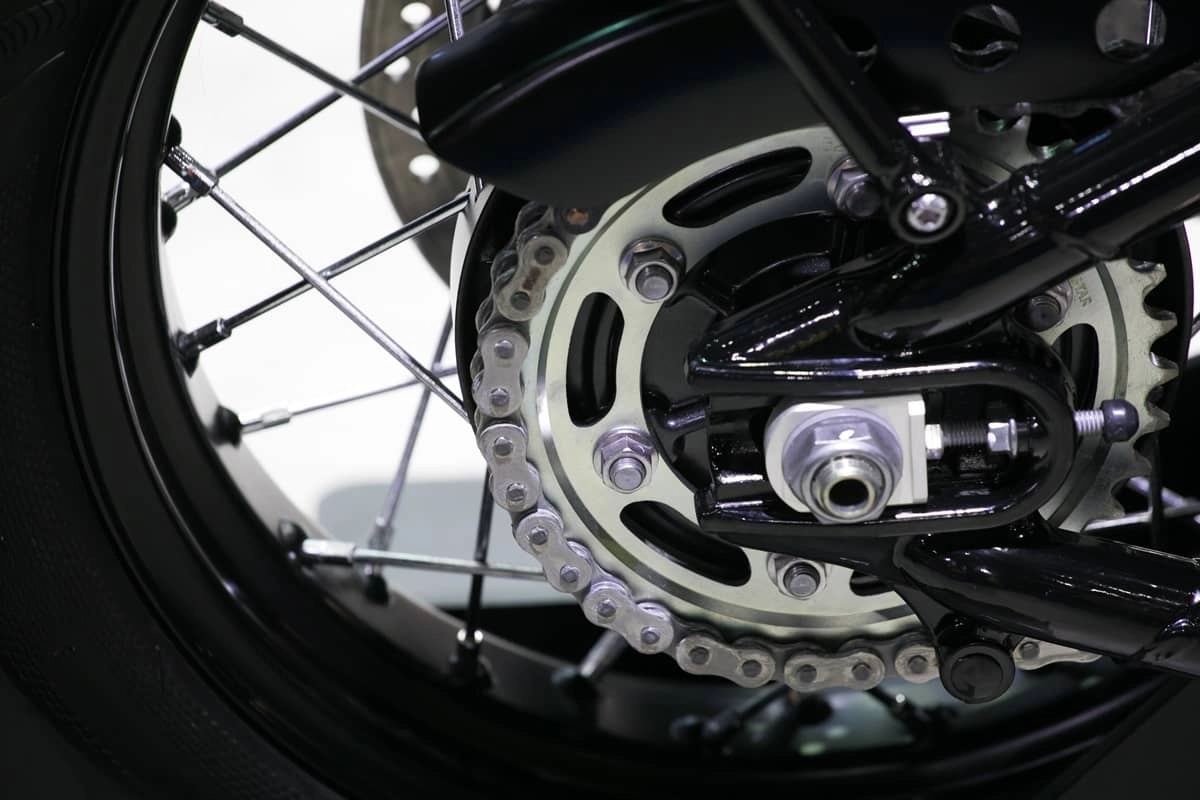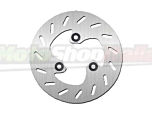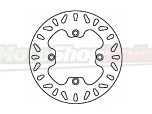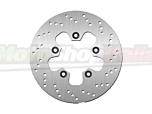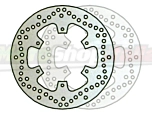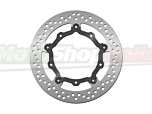When we think of a motorcycle, we often focus on its sparkling aesthetics, the powerful roar of the engine, or the elegant curves it draws on the roads. However, there's a silent hero that ensures not only performance but also the safety of every journey: motorcycle brake discs. These often underestimated discs are crucial for every motorcyclist, whether riding on long country roads or facing the fast pace of the city.
The first question that might arise is: What makes brake discs so crucial? The answer is simple: they are the key to safely and reliably stopping the motorcycle. Imagine riding, the wind against your face, and suddenly needing to slow down or come to a complete stop. It's in that critical moment that the brake discs spring into action, transforming mechanical force into an effective stop command.
Understanding their operation is not just a matter of technique, but also of passion. The brake discs operate through a hydraulic system that, once the brake lever is activated, exerts pressure on the pads against the disc. This contact generates friction, thereby reducing the motorcycle's speed. The beauty of this process lies in its simplicity and efficiency.
The motorcycle brake discs at MotoShopItalia are varied and of quality. The discs can be fixed or floating, with the latter offering greater adaptability to thermal variations and therefore more precise braking and less susceptibility to deformation. The most common material is stainless steel, known for its resistance and thermal stability, but there are also different options like carbon discs, used in the racing world for their lightness and ability to handle high temperatures.
Check out our NG brake discs, known for their robustness and reliability. If you're looking for performance and durability, explore our range of EBC brake discs, a leading brand in the sector. For enthusiasts who want a perfect mix of quality and innovation, Ferodo brake discs are the ideal choice. And don't forget Grimeca brake discs, renowned for their precision and excellent performance. Discover all our products in the brake disc section and find the model that best suits your motorcycle.
Each detail in a brake disc is designed to maximize effectiveness and safety. From the holes that dissipate heat to the grooves for water evacuation, every element has its specific role. These discs are not just pieces of metal, but complex engineering tools, designed to ensure that every motorcycle journey is a safe and thrilling experience.
As motorcyclists or two-wheel experts, we know that every part of our motorcycle deserves attention and care. The brake discs, with their vital function, deserve a special place in this pantheon. Whether it's a Sunday outing on country roads or an adrenaline-filled challenge on the track, trust in our brake discs is what allows us to fully enjoy the freedom that only a motorcycle can offer. So, the next time you hear the sound of the brake, remember: it's the heartbeat of your motorcycle.
Types of Brake Discs
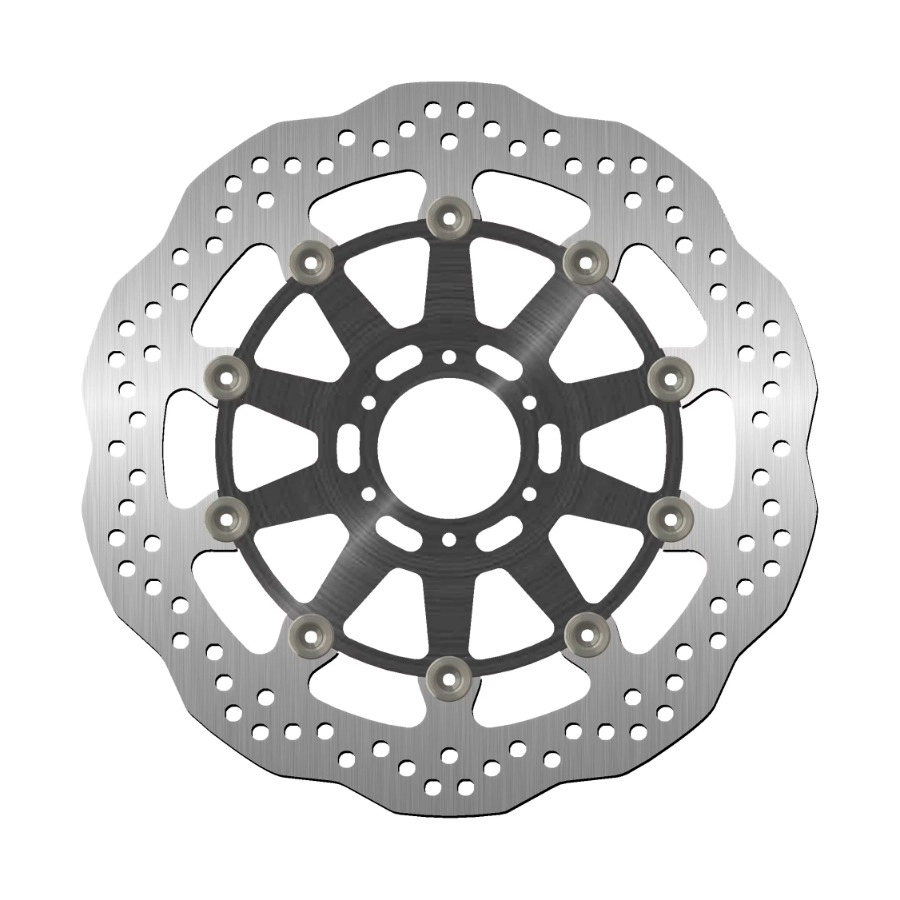
In the world of two-wheelers, choosing brake discs is not just a matter of style, but a real engineering decision that can significantly influence the riding experience.
When it comes to brake discs, we are faced with two main categories, as mentioned before: fixed (standard) discs and floating (galleggianti) discs. Both types have unique characteristics and adapt to different riding styles and needs.
Fixed discs, as the name suggests, are forged in one piece and represent the most traditional and commonly used version. They are robust, reliable, and offer excellent longevity. Thanks to their simple construction, they are also generally more affordable. If your motorcycle is a faithful companion for city streets or non-demanding sporty trips, a fixed disc might be the right choice for you.
Moving to floating discs, we enter the territory of higher performance. These discs are composed of two parts: an outer part that comes into contact with the pads and an inner part, attached to the wheel. The distinctive element is that the outer part can move slightly, allowing better adaptability to thermal variations during intense braking. This feature makes them particularly suitable for sporty use, where braking is more frequent and aggressive. If your passion lies in tight curves or track days, a floating disc could be the winning choice.
The material used for the discs is another crucial factor. Stainless steel is the most common, appreciated for its resistance to corrosion and thermal deformation. Steel discs are versatile, durable, and a safe choice for most motorcyclists.
On the other hand, we have carbon discs, an elite choice inspired by racing. Light and with a high capacity to withstand high temperatures, carbon discs offer exceptional performance but at a higher cost. These discs are ideal for those seeking the ultimate in performance and are not afraid to invest in their passion.
A special mention goes to the daisy brake discs, a stylistic variant that combines aesthetics and functionality. These discs, with their distinctive profile, not only catch the eye but also offer advantages in terms of heat dissipation and pad cleaning.
Exploring our store, you will find a variety of these types, each with its peculiarities. The choice of brake discs is never trivial: it reflects your riding style, your motorcycle, and your needs. Whether you are a fan of Sunday outings or an amateur rider looking for adrenaline, there is always a brake disc waiting to become part of your two-wheeled journey.
Technical Features of Motorcycle Brake Discs
Choosing brake discs for your motorcycle is not just about aesthetic preference or budget. It's a journey into the technical heart of the motorcycle, where every detail has its specific role in ensuring safety and performance.
Let's delve into the technical features of brake discs, exploring how dimensions, shapes, and types of attachment can influence your riding experience.
Starting with dimensions and shapes. Most brake discs have a circular form, but this is just the tip of the iceberg. Within this category, you'll find variations that can make a big difference. For example, Wave discs have wavy edges, which not only offer an aggressive look but also contribute to heat dissipation and clearing debris and water from the pads. This feature makes them particularly suitable for off-road use, where discs are subject to dirt and moisture.
Moving to structure, we have two main options: solid and drilled. Solid discs are more traditional and offer good longevity, but can struggle in terms of heat dissipation during intense use. Drilled discs, on the other hand, have holes distributed across their surface that help keep the disc cool and reduce heat buildup, thus improving performance in conditions of intense braking. These discs are often the preferred choice for riders who like to push the limits, both on the track and on challenging roads.
The attachment of the disc to the wheel rim is another critical aspect. Here, we encounter various options: fixed, floating, semi-floating, and T-Drive. A fixed disc is monolithic and offers a solid and predictable braking feel. Floating discs feature a central part, or bell, that can move independently of the braking surface. This allows greater tolerance to heat and deformations, offering more consistent braking, especially in extreme conditions.
Semi-floating discs are a sort of compromise between fixed and floating, offering some of the benefits of the latter but at a more affordable price and with greater quietness. Finally, Brembo's T-Drive system, one of the latest innovations, features a method of attachment that improves the transmission of forces and heat dissipation, ideal for those seeking peak performance.
Every rider has their preferences and needs, and the choice of brake discs reflects this personal aspect of riding. Whether you're a daily commuter or a passionate rider, understanding the technical features of brake discs will help you make an informed choice, enhancing not only performance but also the safety of your motorcycle. So, the next time you look at your bike's discs, remember: they are not just simple pieces of metal, but sophisticated components that encapsulate years of engineering and innovation.
The Importance of Heat Dissipation in Brake Discs
On an intense riding day, your motorcycle's brake discs work silently but tirelessly, facing one of the most insidious enemies: heat. This heat, generated by friction during braking, if not properly managed, can lead to a phenomenon known as "fading," where the effectiveness of the brake decreases. That's why heat dissipation is a critical aspect in the design and choice of brake discs.
Technologies for managing heat in brake discs have made significant strides in recent years. Starting with drilled discs, which feature holes distributed on their surface. These holes are not just a stylistic element; they act as conduits for air to pass through, thus improving heat dissipation. This helps to keep the temperature of the discs within an optimal range, especially during intense or prolonged braking.
Another remarkable technology is floating discs. The key feature here is their ability to expand and contract in response to temperature changes without warping. This is crucial because, as temperatures rise, materials tend to expand. In a fixed disc, this expansion can lead to deformations, but in a floating disc, the two-part construction allows for absorbing these variations, maintaining the shape and effectiveness of the brake.
Now let's compare materials: Steel vs. Carbon. Stainless steel is the most common material for brake discs, appreciated for its durability, resistance to corrosion, and good heat handling. It's a material that provides a good compromise between performance and cost, making it suitable for most riding situations.
On the other hand, carbon is an elite material, widely used in the racing world. Carbon discs are exceptionally lightweight and offer a high friction coefficient, meaning they can generate more braking power. Another advantage is their incredible resistance to high temperatures, making them almost immune to fading. However, these benefits come at a significantly higher price and require specific riding conditions to best express their potential.
The choice between steel and carbon depends on your riding style and needs. If you are a rider who loves racing or high-performance riding, carbon discs might be the right choice. If, instead, you are a motorcyclist who prefers more leisurely trips or everyday use, stainless steel discs will offer more than adequate performance.
Understanding the management of heat in brake discs is essential. Whether you choose steel or carbon, drilled or floating, remember that each component of your motorcycle has a fundamental role in ensuring a safe and enjoyable ride. Brake discs, in particular, are the silent heroes taking care of your safety at every press of the brake lever.
Maintaining Brake Discs
For a motorcyclist, maintaining brake discs is not just a routine of care, but a ritual that guarantees safety and optimal performance. When it comes to maintaining brake discs, two fundamental aspects emerge: cleaning and checking the thickness. Both these tasks are essential to ensure that the brake discs function at their best and prolong their lifespan.
Let's start with cleaning. It's common for brake discs to accumulate dirt, dust, and pad residues. These deposits not only reduce braking effectiveness but can also cause irregular wear and premature damage to the discs. To clean the discs, it's recommended to use specific brake products, which leave no residue and are effective in removing dirt. A tip is to spray the product on the disc surface and then wipe it off with a clean, dry cloth. This simple action, if performed regularly, can make a significant difference in performance and longevity of the discs.
Checking the thickness is equally important. Every brake disc has a minimum thickness recommended by the manufacturer, and going below this threshold can be dangerous. Periodic measurement of the disc thickness will let you know when it's time to replace them. This check can be performed with a caliper, a simple but valuable tool for every motorcyclist attentive to maintenance. If the thickness of the disc is close to or lower than the recommended limit, it's time to consider a replacement.
In addition to these basic practices, there are some recommendations for a long life of the brake discs. Avoid harsh and prolonged braking, especially with new discs, as they can cause overheating and deformations. Moreover, if you ride in wet or dirty conditions, more frequent cleaning can prevent the accumulation of debris that can abrade the disc surface.
Another tip is to pay attention to the type of brake pads used. Lower quality pads can wear out the discs faster and compromise their performance. Investing in high-quality pads not only improves braking but also protects your discs in the long term.
Regular and careful maintenance of brake discs is not just a matter of vehicle care, but a practice that ensures your safety on the road. Remember, a well-maintained brake disc is not just part of your motorcycle; it's a trusted companion that ensures a safe and enjoyable ride. Take care of your brake discs, and they will take care of you.
Buying Guide: What to Consider Before Purchasing Brake Discs
Choosing the right brake discs for your motorcycle is not like buying any accessory; it's a decision that directly affects your riding experience and, more importantly, your safety. When you're ready to purchase new brake discs, there are two fundamental considerations to keep in mind: compatibility with your motorcycle model and your riding style and types of use.
Let's start with compatibility. Every motorcycle has unique technical specifications that must be respected. This means that not all brake discs are suitable for every motorcycle. The first thing to do is to check the specifications of your motorcycle's manufacturer. What is the recommended disc diameter? What are the minimum and maximum thicknesses? What type of attachment is provided? These pieces of information are crucial to ensure that the brake disc you choose not only fits your motorcycle physically but also works in harmony with the rest of the braking system.
The second key aspect concerns your riding style and usage types. Ask yourself: how and where do I mostly use my motorcycle? If your passion lies in peaceful country road trips, your braking needs will be very different from someone who primarily uses their bike on the track. For riders who love racing or sporty driving, high-performance brake discs, such as floating ones or those made of advanced materials like carbon, can offer an advantage in terms of responsiveness and heat resistance. Conversely, if your motorcycle is mainly a daily means of transportation, standard stainless steel brake discs might be more than sufficient.
Another point to consider is the frequency of braking and the environmental conditions in which you drive. If you live in an area with frequent rain, for example, brake discs with good corrosion resistance and effective water dispersion will be a better choice.
Finally, don't forget to consider your budget. Brake discs can vary significantly in price, and while it's always advisable not to compromise on safety, there are options for every budget.

 Italiano
Italiano
